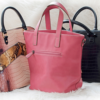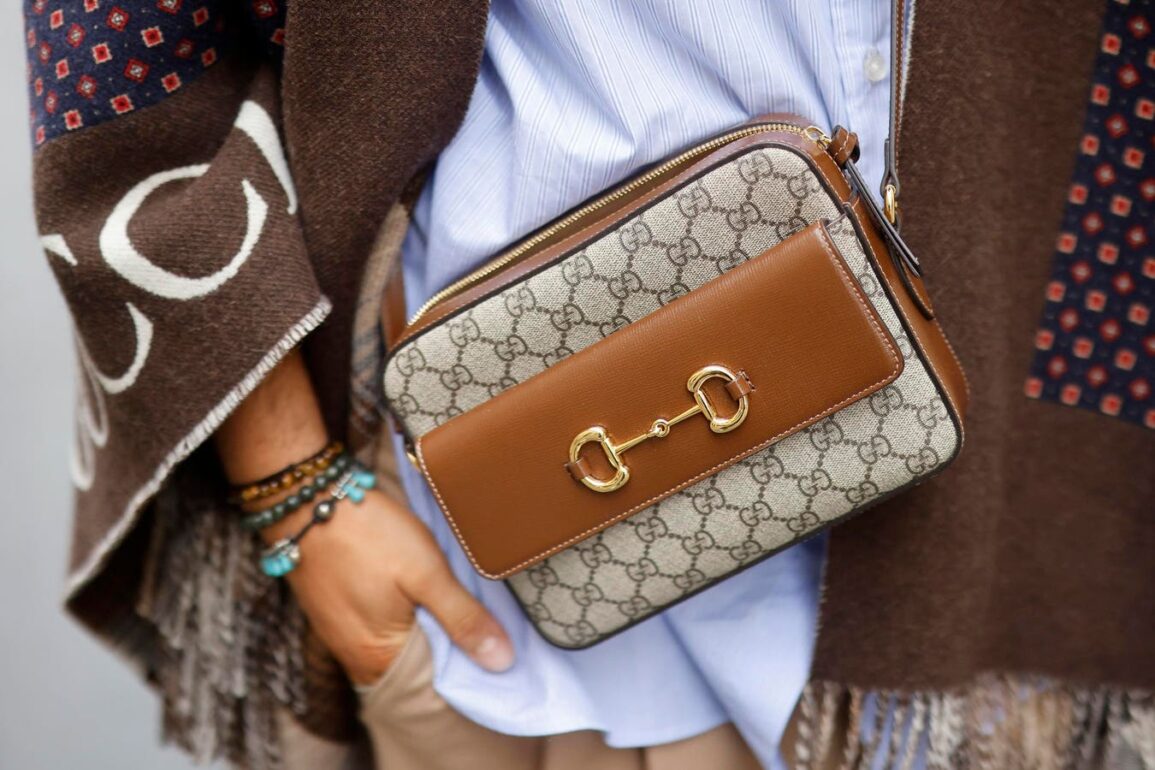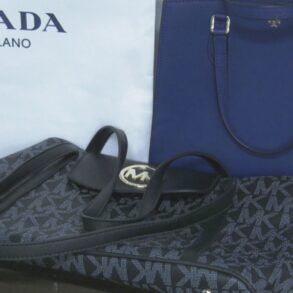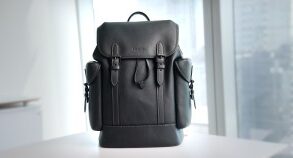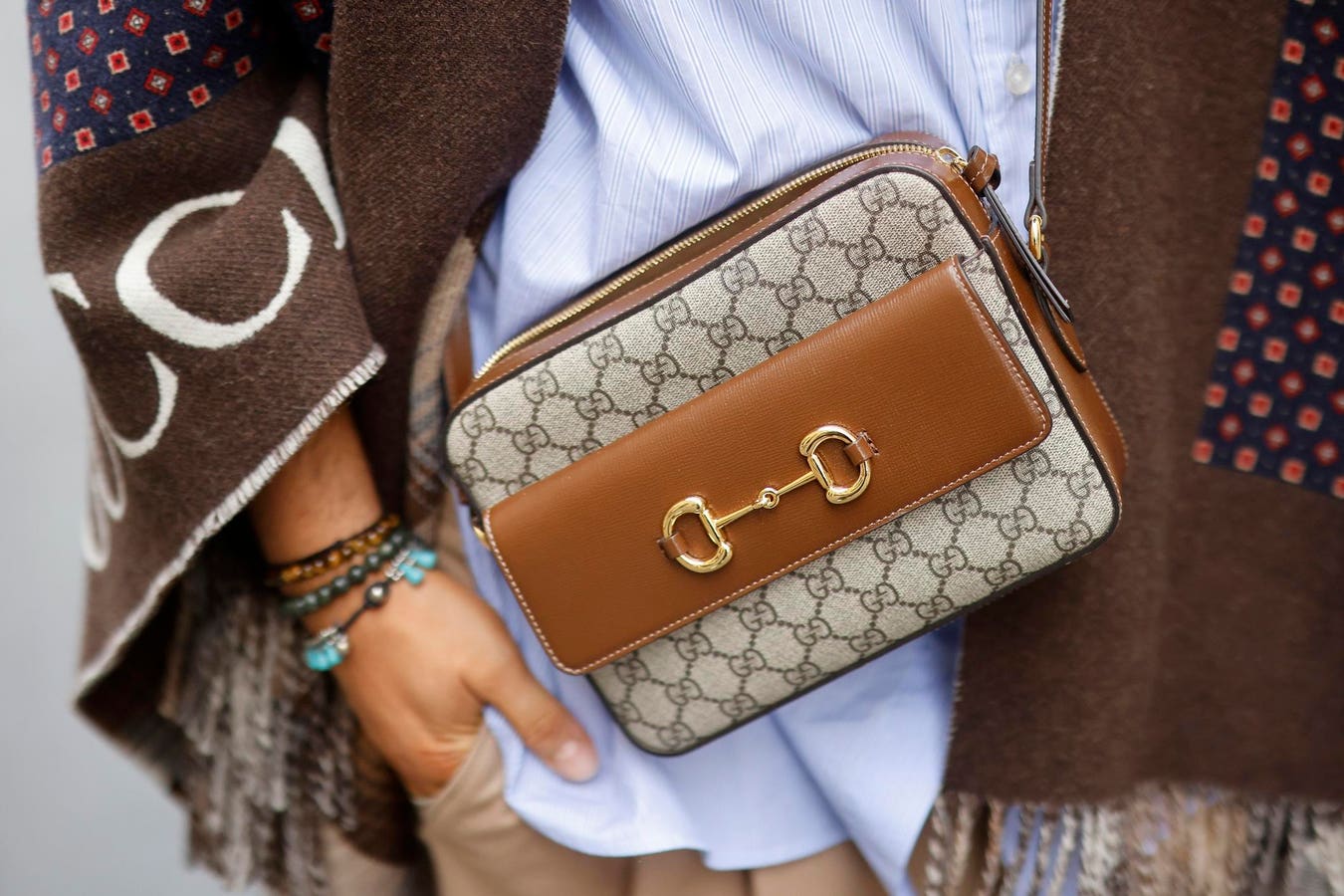
Gucci is celebrating the 70th anniversary of its iconic Horsebit hardware motif, introduced first on men’s loafers in 1953. It tapped the brand archives to host a museum exhibition at Milan Men’s Fashion Week this summer and recruited NewJeans’ Hanni, Halle Bailey, and Julia Garner as the face of a new campaign supporting the Horsebit embellishment in the women’s leather goods collection.
So it was quite a surprise to see Gucci Horsebit 1955 handbags on ShopHQ, the television shopping channel. On offer were two small handbags embellished with the distinctive hardware – one in canvas for $1,690 that looks exactly like the one above and another in leather at $1,800. And both were available with a value pay option to split up payments.
In addition, several other Gucci handbags with the standard double-G logo are featured on the channel’s website. Burberry, Saint Laurent, Valentino and Versace handbags are there, too.
It’s no surprise to see luxury brands touting their cosmetics, perfumes, eyewear and other lower-priced products on television shopping channels, but their bread-and-butter leather goods? While ShopHQ has a limited selection of handbags from these luxury brands, it still has them, and it’s not a good look. ShopHQ did not answer a request for comment.
Being shown on mass TV shopping channels or other discount outlets tarnishes the luxury brand’s reputation and threatens brand equity. Rather than elevating the luxury brand above the masses, it brings them down to mingle among them.
Yet, more luxury brands are likely to turn to these less-than-prestigious discount channels because they are facing a crisis of excess inventory, according to the Wall Street Journal.
Luxury Outlets Are Booming
Many brands got into this fix because they overestimated demand after the post-pandemic sales spike. However, consumers put the brakes on luxury spending this year.
Bain reports that the personal luxury goods market will slow to 4% growth in 2023, after advancing 22% from 2021 to 2022. Luxury brands weren’t prepared and let supply overtake them. They broke a cardinal rule in the luxury market where demand should always exceed supply, not the other way around.
A surplus of inventory has created a boom in luxury outlet sales. From 2022 to 2023, outlet store sales will grow 12%, up from $46 billion in sales to $51 billion, making it the second fastest growing personal luxury goods channel after travel retail, which will advance nearly 40%, but at $16 billion, it is only one-third the size of outlets.
On the other hand, luxury brands have been pulling back from distributing goods in department stores to maintain their exclusive brand image. Part of the reason is that they often discount at season’s end. Department store sales will decline by 10% from 2022 to 2023.
But in pulling back in department stores, they are losing the reputational boost of being featured in upscale stores, like Neiman Marcus, Saks Fifth Avenue and Nordstrom, which are known for curating the best of the best and providing exemplary customer service.
Compare that to what it says of a brand that operates an outlet store all year round in places like Woodbury Common, about an hour outside New York City. Balenciaga, Bottega Veneta, Burberry, Dior, Dolce & Gabbana, Fendi, Givenchy, Gucci, Jimmy Choo, Lavin, Loewe, Loro Piana, Moncler, Prada, Saint Laurent, Valentino among others make homes there.
And Ralph Lauren operates three Woodbury Common outlet stores and a coffee shop. It has nearly four times more outlet stores in the U.S. than it does full-priced branded boutiques, 189 outlets to 48 full-priced stores. While the company doesn’t report revenues generated by outlets, the sheer number of stores alone reveals on which side its bread is buttered.
True Luxury Never Discounts
Professor Jean-Noël Kapferer has literally written the book, or many books, on how luxury brands must behave to retain their luxury brand status. He calls them the “anti-laws of marketing,” which means that if mass, fashion or premium brands turn right, then luxury brands must turn left.
One of the unforgivable sins in luxury marketing is discounting or selling goods in common places that taint their image, such as company outlet stores, television shopping or discount marketplaces like Amazon or TJX Runway.
Kapferer defines luxury as a business model distinct from the fashion or premium model. Critical to the luxury business model’s success is keeping supply far less than demand, maintaining highly selective distribution and never selling at a discount. Those rules don’t apply under the fashion business model.
“Luxury is not a more expensive version of premium, but a completely different mindset,” he affirms and adds, “Although luxury is fashionable today, it is not fashion.”
A key distinctive of the fashion business model is that “these brands chase customers. The luxury strategy, however, demands that customers chase the brands.”
Fashion brands can afford to sell last season’s stuff in outlets; luxury brands cannot. “Too many accessible products create sales but kill brand equity, dream and pricing power,” he writes.
“The luxury strategy is about building incomparability into all the aspects of the brand and thereby maintaining the gap with the many brands that try to grab market share by copying the codes and look of luxury brands,” he continues.
Brands that have resorted to selling in outlet stores and other less prestigious places are guilty of copying the codes of luxury while operating under the fashion business model whose flip side is going out of fashion.
Disposable Fashion Versus Timeless Luxury
Kapferer notes that fashion destroys the value of its products after each season, but true luxury brands build timeless icons or “everlasting SKUs” that are like works of art that never go out of style and whose value increases over time.
It separates Hermès, Chanel and Louis Vuitton from many others claiming luxury status but that actually operate under a fashion business model where outlets are the cost of doing business.
“In the fragile fashion business model, products sell by being fashionable, which means capturing the spirit of the moment. With time, fashion fades away, and products need to be heavily discounted. In contrast, the essence of luxury brand management is time. Luxury takes time, and luxury sells time.
“Luxury brands need cult products that fix the dreams of clients, after which they can wait for the moment those consumers are ready to indulge (e.g., ‘One day I will buy a Cartier Santos watch, Rolex Daytona, Jaeger Lecoultre Reverso’). There is no hurry, because the products are here to stay, and the price will remain. True luxury never offers discounts or rebates,” he concludes.
This post was originally published on this site be sure to check out more of their content.

